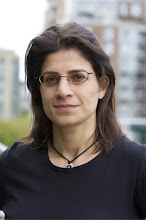Saturday, November 28, 2009
Notables 2: "Population, Arithmetic, and Energy" by Prof. Albert A. Bartlett
This is an 8-part presentation by Prof. Albert A. Bartlet on the importance of understanding the exponential function and growth rate.
Monday, November 23, 2009
Friday, November 13, 2009
Thursday, November 5, 2009
Math Text Book Assessment
Group members: Amelia, Mina, Rory, Rosemary, and Sam
7/10 for heaviness. Quite solid, but not too heavy. Uniformly dense.
Durable enough to be thrown on the ground.
It smells like teen spirit.
Pages are typical with regard to thickness.
Latest publication date = 1999.
Expected durability = 5-10 years.
Authors: Robert Alexander & Brendan Kelly + 11 co-authors.
Authors are mostly teachers and math educators.
Preface lays out the general format to be used in the upcoming chapters.
Chapters are based on specific units, which are further subdivided into different topics.
Typical answer key, glossary and index.
Rory was pleased by the frog on the front cover.
Page layout uses a good amount of white space and doesn’t overwhelm the reader with information.
Good use of photos and diagrams. Varied fonts for overall aesthetic appeal.
Friendly and accessible.
PLOs for Trig in the IRP have more emphasis on unit circles than in AW.
Extra material on probability, stats and conic sections.
Chapter sequence is logical. Builds up concept of function and expands with sinusoidal & logarithmic functions.
Includes material which correlates to PLOs; ie: citizenship education (equality of sexes, etc.).
Incorporates use of technology.
Usefulness for new/experienced teachers?
Usefulness for students/self directed learning?
Wednesday, November 4, 2009
In-class timed writing (8 min) - Two memorable stories about the practicum experience
It happened when I was teaching a math 11 class. I was explaining the standard form of a the most general quadratic function and its graphical representation as a parabola and having a dialogue with the students through looking at equations, having a table of values, and graphing. I demonstrated how different parameters in the equation were responsible in changing the shape of the graph, translating it along the x- or y-axis, and reflecting it about the x-axis. We were doing few examples, going back and forth between the table of values, the equation, and the graph, determining the axis of symmetry, the vertex, the opening direction, the x- and y-intercepts, ... It was at this point where one of the students from the back row yelled with excitement "AH... I get it!". At that moment, I stopped, acknowledged him, and told the whole class, "I love these "Ah ha" moments!
The "Jigsaw activity" for matching compound names and formulas
My SA suggested a jigsaw activity for helping the grade 9 science students in naming and finding chemical names for chemical compounds. I took the 2nd half of a science 9 class to the gym, handed out pieces of cut paper with names either the name or formula of a compound, and asked them to go around the room and find the other student with the corresponding formula or name. Once they found their partner, they were supposed to sit down. At the end, when everyone had found their partners, I went around, picked few students and asked them how they found the matching name or formula. I felt like I had a strong presence and had convinced the students of the significant point of the activity, i.e. not memorizing how many electrons a given element is willing to give or take to form an ionic bond, but to know how the exchange is made and how many atoms of each element were required such that there is a balance of charges at the end, forming a electrically neutral object.
Monday, November 2, 2009
Poem on "Division by Zero"
How many zeros can you fit in anything, any number, any shape, any place, at any given time?
Are there infinite zeros in anything, any number, any shape, any place, at any given time?
What is revealed when diving by zero anyways? What is infinity?
Does a task or a chunk become smaller when it's divided by zero?
Division by zero looks like something on top of zero.
There is a line Between the number and zero when dividing that number by zero.
Divide and conquer does not work when dividing by zero, does it?
Division by zero does not imply inverse of multiplying by zero!
Reflection on this exercise:
A worthy exercise, but I don't see/get its relevance or importance.
Maybe because my background is in physics?
Would you use it in your classes? How?
I don't know... Honestly, probably not. I'd rather use something or some
activity related to sports than poetry when discussing a concept. This
is because I have participated in different types of sports all my life.



